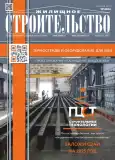The necessity of revising current insolati on standards in architectural practice
- Authors: Petrov A.S.1, Ivantsov A.I.1
-
Affiliations:
- Kazan State University of Architecture and Engineering
- Issue: No 10 (2024)
- Pages: 44-51
- Section: Articles
- URL: https://modernonco.orscience.ru/0044-4472/article/view/641758
- DOI: https://doi.org/10.31659/0044-4472-2024-10-44-51
- ID: 641758
Cite item
Abstract
In architectural practice, a stable understanding has developed about the positive aspect of insolation of premises and territories, which consists in the sanitization of premises with the UV part of the spectrum, erythema effect on humans, thermal effect on buildings, and regulation of building density. An analysis of the current insolation standards is given to take into account each of the above factors. It is shown that most of them are not only not taken into account, but the very ideology of the positive impact of insolation of premises and territories is lost. The identified problems and contradictions suggest the need to revise the current insolation standards. A method for determining calendar dates for excluding insolation based on the duration of overheating of a room in the summer is proposed. Examples of architectural solutions are given in which the current insolation standards and calculation methods conflict with each other. Justifications are proposed for revising the standards for insolation of premises and territories while maintaining the required building density.
Full Text
About the authors
A. S. Petrov
Kazan State University of Architecture and Engineering
Author for correspondence.
Email: ruarty@mail.ru
Candidate of Sciences (Engineering)
Russian Federation, 1, Zelenaya st., Kazan, 420043A. I. Ivantsov
Kazan State University of Architecture and Engineering
Email: ivantsov.arch@mail.ru
Candidate of Sciences (Engineering)
Russian Federation, 1, Zelenaya st., Kazan, 420043References
- Andreeva P.N. Personal right to insolation: content and development prospects. Legal Science and Practice: Vestnik of the Nizhny Novgorod Academy of the Ministry of Internal Affairs of Russia. 2017. No. 4 (40), pp. 239–246. (In Russian). EDN: ZXRFYF.
- Kupriyanov V.N. Accounting for sun protection devices when calculating natural lighting of premises. Zhilishchnoe Stroitel’stvo [Housing Construction]. 2023. No. 8, pp. 28–36. (In Russian). https:// doi.org/10.31659/0044-4472-2023-8-28-36
- Shmarov I.A., Zemtsov V.A., Korkina E.V. Insolation: practice of standardization and calculation. Zhilishchnoe Stroitel’stvo [Housing Construction]. 2016. No. 7, pp. 48–54. (In Russian). EDN: WHFUWD
- Soloviev A.K., Dorozhkina E.A. Modern understanding of the role of natural lighting in the design of buildings. Zhilishchnoe Stroitel’stvo [Housing Construction]. 2021. No. 11, pp. 46–52. (In Russian). https://doi.org/10.31659/0044-4472-2021-11-46-52
- Kupriyanov V.N., Khalikova F.R. Transmission of ultraviolet radiation by window glass at different angles of incidence of the beam. Zhilishchnoe Stroitel’stvo [Housing Construction]. 2012. No. 6, pp. 64–65. (In Russian). EDN: NRBBUG
- Ivantsov A.I., Petrov A.S. On the issue of increasing the energy saving class of residential buildings due to architectural, structural and other parameters. Izvestiya of the Kazan State University of Architecture and Civil Engineering. 2022. No. 4 (62), pp. 40–50. (In Russian). https://doi.org/10.52409/20731523_2022_4_40
- Kupriyanov V.N. Towards the calculation of the solar factor of sun protection devices. Zhilishchnoe Stroitel’stvo [Housing Construction]. 2021. No. 11, pp. 40–45. (In Russian). EDN: QRWCFZ. https:// doi.org/10.31659/0044-4472-2021-11-40-45
- Kupriyanov V.N. On the assessment of thermal comfort of rooms irradiated by solar radiation through light openings. Part 1. Calculation of solar radiation energy coming to the outer surface of the light opening. Vestnik of the Volga territorial branch of the Russian Academy of Architecture and Construction Sciences. 2019. Iss. 22, pp. 191–196. (In Russian).EDN: ZWSDBR.
- Kupriyanov V.N. On the assessment of thermal comfort of rooms exposed to solar radiation through light openings. Part II. Calculation of the increment of indoor air temperature due to solar radiation passed through the glazing. Collection of scientific papers of the RAASN. Moscow: ASV. 2019. Vol. 2, pp. 316–325. (In Russian). https://doi.org/10.22337/9785432303134-316-325
- Petrov A.S. Estimation of the duration of indoor comfort using computer modeling. Zhilishchnoe Stroitel’stvo [Housing Construction]. 2023. No. 8, pp. 43–52. (In Russian). https://doi.org/10.31659/0044-4472-2023-8-43-52
- Petrov A.S., Zabirova A.I. On the issue of providing the level of thermal comfort in residential apartments, taking into account the PMV and PPD indices. Izvestiya of the Kazan State University of Architecture and Civil Engineering. 2019. No. 3 (49), pp. 139–146. (In Russian).
- Ivantsov A.I. To the calculation of the influence of solar radiation on the heat losses of premises through glazed balconies and loggias. Zhilishchnoe Stroitel’stvo [Housing Construction]. 2023. No. 8, pp. 37–42. (In Russian). https://doi.org/10.31659/0044-4472-2023-8-37-42
- Shengkai Zhao, Liu Yang, Siru Gao, Yongchao Zhai. Field study on human thermal comfort and indoor air quality in university dormitory buildings. E3S Web Conf. 2022. 356 03015. https://doi.org/10.1051/e3sconf/202235603015
- Pablo Aparicio-Ruiz, Elena Barbadilla-Martín, José Guadix, Jesús Muñuzuri. A field study on adaptive thermal comfort in Spanish primary classrooms during summer season. Building and Environment. 2021. Vol. 203. 108089. https://doi.org/10.1016/j.buildenv.2021.108089
- Valeria De Giuli, Roberto Zecchin, Livio Corain, Luigi Salmaso, Measured and perceived environmental comfort: Field monitoring in an Italian school. Applied Ergonomics. 2014. Vol. 45. Iss. 4, pp. 1035–1047. https://doi.org/10.1016/j.apergo.2014.01.004
- Bin Yang, Thomas Olofsson, Faming Wang, Weizhuo Lu, Thermal comfort in primary school classrooms: A case study under subarctic climate area of Sweden. Building and Environment. 2018. Vol. 135, pp. 237–245. https://doi.org/10.1016/j.buildenv.2018.03.019
- A. Jindal, Thermal comfort study in naturally ventilated school classrooms in composite climate of India. Build. Environ. 2018. No. 142, pp. 34–46. https://doi.org/ 10.1016/j.buildenv.2018.05.051
- Zaretskaya M.A., Psarov S.A., Shumilin E.V. Thermal comfort in a room when using various translucent structures and heating devices. Uchenyye zametki TOGU. 2013. Vol. 4. No. 4, pp. 1586–1590. (In Russian).
- Mora R., Metayer M. Thermal comfort in healthcare institutions. Energosberezheniye. 2022. No. 8, pp. 48–55. (In Russian).
- Kupriyanov V.N. Increment of indoor air temperature under the influence of solar radiation through a light opening. Izvestiya of the Kazan State University of Architecture and Civil Engineering. 2022. No. 4 (62), pp. 6–17. (In Russian). EDN: UIXOZF. https://doi.org/10.52409/20731523_2022_4_6
- Kupriyanov V.N., Sedova F.R. Justification and development of the energy method for calculating insolation of residential premises. Zhilishchnoe Stroitel’stvo [Housing Construction]. 2015. No. 5, pp. 83–87. (In Russian). EDN: RUOCDL.
Supplementary files












